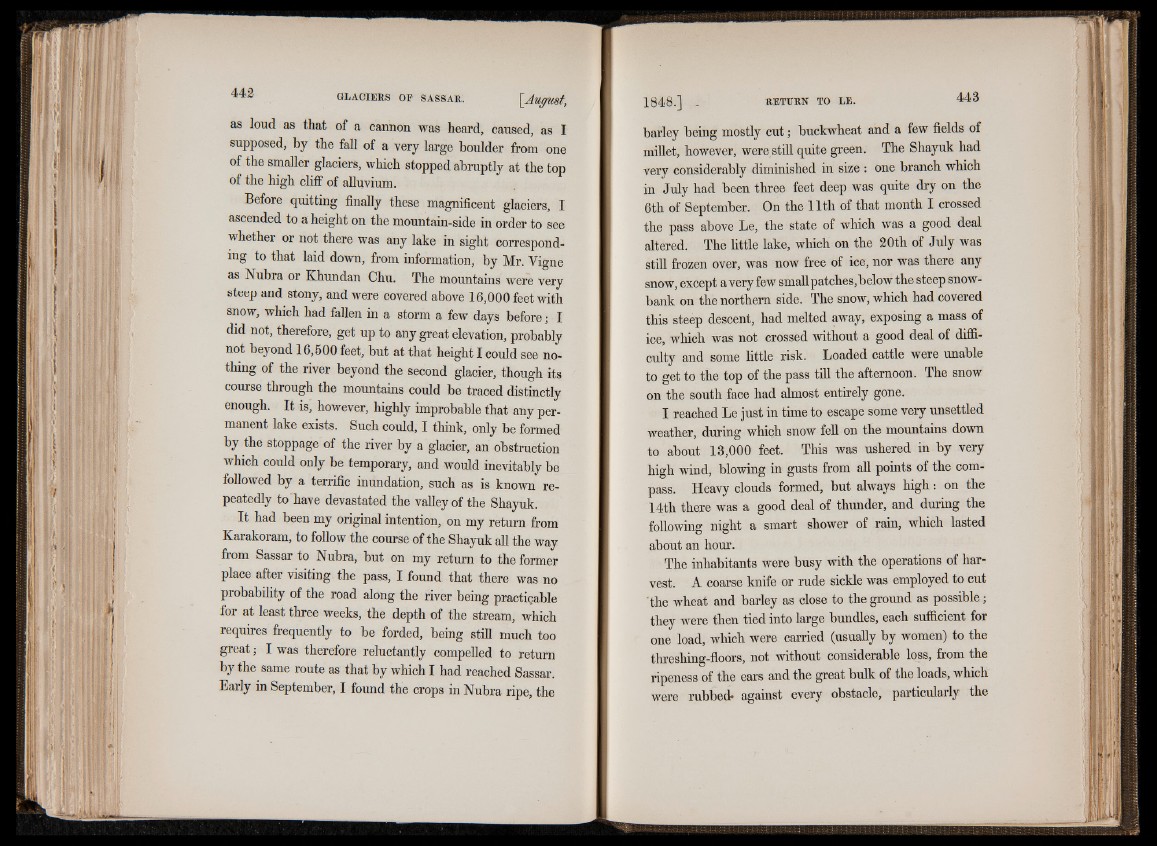
as loud as that of a cannon was heard, caused, as I
supposed, by the fall of a very large boulder from one
of the smaller glaciers, which stopped abruptly at the top
of the high cliff of alluvium.
Before quitting finally these magnificent glaciers, I
ascended to a height on the mountain-side in order to see
whether or not there was any lake in sight corresponding
to that laid down, from information, by Mr. Vigne
as Nubra or Khundan Chu. The mountains were very
steep and stony, and were covered above 16,000 feet with
snow, which had fallen in a storm a few days before; I
did not, therefore, get up to any great elevation, probably
not beyond 16,500 feet, but at that height I could see nothing
of the river beyond the second glacier, though its
course through the mountains could be traced distinctly
enough. It is, however, highly improbable that any permanent
lake exists. Such could, I think, only be formed
by the stoppage of the river by a glacier, an obstruction
which could only be temporary, and would inevitably be
followed by a terrific inundation, such as is known repeatedly
to have devastated the valley of the Shayuk.
It had been my original intention, on my return from
Karakoram, to follow the course of the Shayuk all the way
from Sassar to Nubra, but on my return to the former
place after visiting the pass, I found that there was no
probability of the road along the river being practicable
for at least three weeks, the depth of the stream, which
requires frequently to be forded, being still much too
great; I was therefore reluctantly compelled to return
by the same route as that by which I had reached Sassar.
Early in September, I found the crops in Nubra ripe, the
barley being mostly cut; buckwheat and a few fields of
millet, however, were still quite green. The Shayuk had
very considerably diminished in size : one branch which
in July had been three feet deep was quite dry on the
6th of September. On the 11th of that month I crossed
the pass above Le, the state of which was a good deal
altered. The little lake, which on the 20th of July was
still frozen over, was now free of ice, nor was there any
snow, except a very few small patches, below the steep snowbank
on the northern side. The snow, which had covered
this steep descent, had melted away, exposing a mass of
ice, which was not crossed without a good deal of difficulty
and some little risk. Loaded cattle were unable
to get to the top of the pass till the afternoon. The snow
on the south face had almost entirely gone.
I reached Le just in time to escape some very unsettled
weather, during which snow fell on the mountains down
to about 13,000 feet. This was ushered in by very
high wind, blowing in gusts from all points of the compass.
Heavy clouds formed, but always high: on the
14th there was a good deal of thunder, and during the
following night a smart shower of rain, which lasted
about an hour.
The inhabitants were busy with the operations of harvest.
A coarse knife or rude sickle was employed to cut
‘the wheat and barley as close to the ground as possible ;
they were then tied into large bundles, each sufficient for
one load, which were carried (usually by women) to the
threshing-floors, not without considerable loss, from the
ripeness of the ears and the great bulk of the loads, which
were rubbed* against every obstacle, particularly the